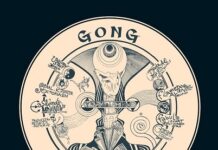Keith Emerson, despite a series of misfortunes and miscalculated career moves, is still considered a legendary virtuoso of the keyboards. The Nice and ELP fading in his rear-view mirror, the 60-something musician works tirelessly these days, attempting to establish himself as a solo artist on an integral level. For the last couple of years, he’s toured relentlessly — playing clubs, casinos, opening slots and just about anywhere else that will have him and his band. The 2002 piano-based CD Emerson Plays Emerson, available as an import only, was an affirmative step forward as the keyboardist tastefully blended standards and one-off collaborations with an assortment of original compositions. But, on the whole, Emerson’s solo forays have been haphazard and well below the caliber of musicality he established in the 70s. Taking stock, the rollout of Honky, At The Movies, and Off The Shelf portray a career strewn with a mixture of brilliance, inanity, and melancholy of the last 25 years.
Part of the problem with Keith Emerson’s solo experiments is a reliance on his colorful past. Even as he has occasionally returned to form with a luminous new piece here and there, he can’t seem to turn away from overdone adaptations, including numerous re-recordings of Mussorgsky’s “Pictures At An Exhibition.” Emerson made an admirable effort to shake off his status with an atypical solo record he inappropriately called
Honky. The record did little to further his tarnishing reputation; yet reeked of fanciful emancipation. Emerson, on an extended vacation in the Bahamas, rounded up a crew of local musicians and exploded with a wild variation of calypso and reggae tunes — foreign substances to the legions of ELP fanatics who were expecting something less whimsical and more monumental. But really — you can’t blame him for turning his back on the “legendary” noose around his neck and indulging seafaring gems like “Hello Sailor” and “Rum-A-Ting.” And the irresistible boogie woogie of Meade Anderson “Lux” Lewis’ “Yancey Special” shakes the manacles off completely. In spite of the artistic liberation he may have enjoyed, Honky, originally released in 1981 on the Italian Bubble label, barely made a ripple with the record-buying public.
When he sobered up and paid the bar bill, Keith Emerson packed his bags and returned to the mainland. Major shifts in musical preferences had occurred in his absence. Pretentious progressive rock was branded passé’ and collecting dust, while a new wave of bands dominated the radio dial and a curious new phenomenon called MTV. The keyboardist decided to try his hand at film work, a logical move considering the cinematic quality of his music. The three-CD At The Movies extensively chronicles this elongated stage of Emerson’s career. His mood music arrangements embellished obscure Italian macabre films like Inferno and La Chiesa, as well as more mainstream thrillers such as Nighthawks (starring Sylvester Stallone) and a Japanese sequel of Godzilla called Gojira (Godzilla). Even though soundtrack, incidental music of this nature isn’t something a lot people sit around listening to, Emerson’s talents are in full stride throughout. The catchy theme for Nighthawks drives the film’s intricate plot. Boston vocalist Brad Delp lends his pipes to the rousing “Playing For Keeps” from Best Of Revenge just to show Emerson could still rock reasonably well. But if you’re feeling brave, there’s nothing more challenging than digging into the brooding themes explored on the second and third discs comprising scores for the Italian and Japanese films he was involved with. That’s what really separates the rockers from the musicians.
Off The Shelf mostly consists of throwaways and scraps from years gone by. That and a generous helping of his past achievements still go a long way. The orchestral arrangement of “Abandon’s Bolero” takes greater care in building the momentum than ELP did in 1972. But “Pictures At An Exhibition,” even in its brevity, falls into the trap of its all-too-familiar presentation.
Clearly, the true allure of Emerson’s genius is no more evident than when he sits behind a grand piano. It wouldn’t matter if he played “Chopsticks” blind-folded, the man can still pull off more lively trills and inverted mordents than anyone of his generation. Which is why the stark, angular lines of “And The January” are so captivating. His extraneous capabilities on piano, Hammond organ and Moog synthesizer get a vigorous workout when he teams up with the London Jazz Orchestra for zesty versions of Charlie Parker’s be boppin’ “Au Privave” and Gary Burton’s “Walter L.”
The only obstacle standing in the way of Emerson becoming a full-time classical or jazz pianist is his love for rock and roll. This works both for and against him on Off The Shelf. It’s not that he insists on recording yet another take of “America,” this time with Pat Travers on guitar. Nor can you blame him and the Nice for their quick and clever stab at Frank Zappa’s “Lumpy Gravy.” Keith Emerson undermines his good name by dabbling in silly fare like “Don’t Be Cruel” and “Sex & Drugs & Rock & Roll” — great songs when performed by simple and solid rock bands, yet disastrous when the maestro takes it down a notch for the sake of novelty. On that note, even “Straight Between The Eyes,” originally written for the Best Revenge film and sung by the Band’s Levon Helm, lacks the conviction and heart fans have to come to expect from Keith Emerson.
Efficiently packaged with plenty of informative liner notes and pictures, these archival remasters will surely satisfy core fans in search of every recorded note. But the real question is: How about something new and adventurous? One could assume Emerson is biding his time and filling the well until the demand for an ELP reunion becomes too tempting to blow off. But adapting a soubrique like Emo, recycling old music, and trying to reel in a new audience is a daunting task for a master like Keith Emerson.
~ Shawn Perry




















